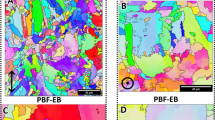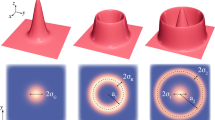Abstract
To provide a broad processing window with a high deposition rate, a comprehensive analysis of single-track geometrical characteristics over a wide range of laser energies and mass inputs in laser cladding is necessary. The formation of a single cladding track of Inconel 718 on a substrate by coaxial laser cladding, with a wide range of laser power from 1 200 W to 3 900 W and a powder feeding rate from 5 g/min to 35 g/min, was studied from both theoretical and experimental points of view. A quantitative model of powder concentration distribution was developed based on the powder transport morphology obtained by high-speed photography. Linear regression models were established between nine geometrical characteristics and the combined process parameters of laser power and powder feeding rate, written as PαFβ, to quantitatively analyze the geometrical characteristics of the clad. These were confirmed by large correlation coefficients and analysis of residuals. From the findings we deduced that more energy input enhanced the outward direction of Marangoni convection, leading to the melt pool undergoing evolution from shallow dilution and flat dilution to fluctuating dilution. An almost linear relationship was found between the cladding width, W, and the laser power, indicating that laser energy accumulation was a major factor in the evolution of W. The increase ratio of the cladding height, hc, ranged from 640% to 360% along with an increase in the powder feeding rate, implying that the evolution of hc, was dominated by the powder feeding rate. The total area of the cross-section, A; the area of the clad, Ac; the area of the molten substrate, Am; the total height of the cross-section, H; the penetration depth, hm; the dilution ratio, D; and the wetting angle, θ, were determined by a complex coupling of energy input and mass accumulation, and they are proportional to P0.5F0.2, P0.2F0.5, P0.5/F0.2, P0.3F, P0.5/F0.2, P0.2/F0.2, and P0.2/F0.2, respectively. This research aims to provide general knowledge on the influence of energy input and mass addition on the geometrical characteristics of the clad and its related influence mechanism. Such information could provide a reference and basis for promoting the practical application of laser cladding technology.






























Similar content being viewed by others
References
Zhang DK, Yu RQ, Chen K et al (2018) Corrosion and corrosion-friction properties of plasma cladding wear-resistant layer on Fe-based alloy. Mater Res Express 5(2):026525. https://doi.org/10.1088/2053-1591/aaae7f
Tarasova T, Gvozdeva G, Ableyeva R (2019) Aluminium matrix composites produced by laser based additive manufacturing. Mater Today Proc 11:305–310
Onuike B, Heer B, Bandyopadhyay A (2018) Additive manufacturing of Inconel 718-Copper alloy bimetallic structure using laser engineered net shaping (LENS (TM)). Addit Manuf 21:133–140
Liu ZC, Jiang QH, Li T et al (2016) Environmental benefits of remanufacturing: a case study of cylinder heads remanufactured through laser cladding. J Clean Prod 133:1027–1033
Hosseini E, Popovich VA (2019) A review of mechanical properties of additively manufactured Inconel 718. Addit Manuf 30:100877. https://doi.org/10.1016/j.addma.2019.100877
Lewandowski JJ, Seifi M (2016) Metal additive manufacturing: a review of mechanical properties. Annu Rev Mater Res 46(1):151–186
Shao JY, Yu G, Li SX et al (2022) Crystal growth control of Ni-based alloys by modulation of the melt pool morphology in DED. J Alloys Compd 898(25):162976. https://doi.org/10.1016/j.jallcom.2021.162976
Limmaneevichitr C, Kou S (2000) Experiments to simulate effect of Marangoni convection on weld pool shape. Weld J 79(8):231S-237S
Wei PS, Ting CN, Yeh JS et al (2009) Origin of wavy weld boundary. J Appl Phys 105(5):053508. https://doi.org/10.1063/1.3065533
Robert A, Debroy T (2001) Geometry of laser spot welds from dimensionless numbers. Metall Mater Trans B 32(5):941–947
Lu NN, Lei ZL, Yu XF et al (2021) Effects of melt convection on stray grain formation in single crystal superalloys during directed energy deposition. Addit Manuf 48:102429. https://doi.org/10.1016/j.addma.2021.102429
Zhang J, Yang L, Zhang W et al (2020) Numerical simulation and experimental study for aerodynamic characteristics and powder transport behavior of novel nozzle. Opt Laser Eng 126:105873. https://doi.org/10.1016/j.opdaseng.2019.105873
Kovalev OB, Kovaleva IO, Smurov IY (2017) Numerical investigation of gas-disperse jet flows created by coaxial nozzles during the laser direct material deposition. J Mater Process Technol 249:118–127
Nagulin KY, Iskhakov FR, Shpilev AI et al (2018) Optical diagnostics and optimization of the gas-powder flow in the nozzles for laser cladding. Opt Laser Technol 108:310–320
Tan H, Zhang FY, Wen RJ et al (2012) Experiment study of powder flow feed behavior of laser solid forming. Opt Laser Eng 50(3):391–398
Wu JZ, Zhao PH, Wei HY et al (2018) Development of powder distribution model of discontinuous coaxial powder stream in laser direct metal deposition. Powder Technol 340:449–458
Amirjan M, Khodabandeh M (2022) Correlation between processing parameters in direct metal deposition of IN625 Nickel-base superalloy. J Mater Eng Perform 31:1373–1386
Shayanfar P, Daneshmanesh H, Janghorban K (2020) Parameters optimization for laser cladding of Inconel 625 on ASTM A592 steel. J Mater Res Technol 9(4):8258–8265
Mazzarisi M, Campanelli SL, Angelastro A et al (2020) Phenomenological modelling of direct laser metal deposition for single tracks. Int J Adv Manuf Technol 111(7/8):1955–1970
Alizadeh-Sh M, Marashi SPH, Ranjbarnodeh E et al (2020) Laser cladding of Inconel 718 powder on a non-weldable substrate: clad bead geometry-solidification cracking relationship. J Manuf Process 56:54–62
Jelvani S, Razavi RS, Barekat M et al (2020) Empirical-statistical modeling and prediction of geometric characteristics for laser-aided direct metal deposition of Inconel 718 superalloy. Met Mater Int 26(5):668–681
Bax B, Rajput R, Kellet R et al (2018) Systematic evaluation of process parameter maps for laser cladding and directed energy deposition. Addit Manuf 21:487–494
Nabhani M, Razavi RS, Barekat M (2018) An empirical-statistical model for laser cladding of Ti-6Al-4V powder on Ti-6Al-4V substrate. Opt Laser Technol 100:265–271
Erfanmanesh M, Abdollah-Pour H, Mohammadian-Semnani H et al (2017) An empirical-statistical model for laser cladding of WC-12Co powder on AISI 321 stainless steel. Opt Laser Technol 97:180–186
Ansari M, Razavi RS, Barekat M (2016) An empirical-statistical model for coaxial laser cladding of NiCrAlY powder on Inconel 738 superalloy. Opt Laser Technol 86:136–144
Barekat M, Razavi RS, Ghasemi A (2016) Nd: YAG laser cladding of Co-Cr-Mo alloy on γ-TiAl substrate. Opt Laser Technol 80:145–152
El Cheikh H, Courant B, Branchu S et al (2012) Analysis and prediction of single laser tracks geometrical characteristics in coaxial laser cladding process. Opt Laser Eng 50(3):413–422
Ocelík V, de Oliveira U, de Boer M et al (2007) Thick Co-based coating on cast iron by side laser cladding: analysis of processing conditions and coating properties. Surf Technol 201(12):5875–5883
de Oliveira U, Ocelik V, De Hosson JTM (2005) Analysis of coaxial laser cladding processing conditions. Surf Technol 197(2/3):127–136
Costa L, Felde I, Reti T et al (2003) A simplified semi-empirical method to select the processing parameters for laser clad coatings. Mater Sci Forum 414/415:385–394
El Cheikh H, Courant B, Hascoet JY (2012) Prediction and analytical description of the single laser track geometry in direct laser fabrication from process parameters and energy balance reasoning. J Mater Process Technol 212(9):1832–1839
Davim JP, Oliveira C, Cardoso A (2008) Predicting the geometric form of clad in laser cladding by powder using multiple regression analysis (MRA). Mater Des 29(2):554–557
Gullipalli C, Thawari N, Chandak A (2022) Statistical analysis of clad geometry in direct energy deposition of Inconel 718 single tracks. J Mater Eng Perform 31(8):6922–6932
Zhao Y, Guan C, Chen LY et al (2020) Effect of process parameters on the cladding track geometry fabricated by laser cladding. Optik 223:165447. https://doi.org/10.1016/j.ijleo.2020.165447
Pant P, Chatterjee D, Nandi T et al (2019) Statistical modelling and optimization of clad characteristics in laser metal deposition of austenitic stainless steel. J Braz Soc Mech Sci Eng 41:283. https://doi.org/10.1007/s40430-019-1784-x
Saqib S, Urbanic RJ, Aggarwal K (2014) Analysis of laser cladding bead morphology for developing additive manufacturing travel paths. Procedia CIRP 17:824–829
Sun YW, Hao MZ (2012) Statistical analysis and optimization of process parameters in Ti6Al4V laser cladding using Nd: YAG laser. Opt Laser Eng 50(7):985–995
Zhang J, Zhang QL, Chen ZJ et al (2019) Experimental and statistical analyses of geometry characteristics of Inconel 718 laser clad layer with response surface methodology. J Laser Appl 31(3):032016. https://doi.org/10.2351/1.5098044
Wang SH, Zhu LD, Fuh JYH et al (2020) Multi-physics modeling and Gaussian process regression analysis of cladding track geometry for direct energy deposition. Opt Laser Eng 127:105950. https://doi.org/10.1016/j.optlaseng.2019.105950
Pant P, Chatterjee D (2020) Prediction of clad characteristics using ANN and combined PSO-ANN algorithms in laser metal deposition process. Surf Interfaces 21:100699. https://doi.org/10.1016/j.surfin.2020.100699
Guo CG, He SZ, Yue HT et al (2021) Prediction modelling and process optimization for forming multi-layer cladding structures with laser directed energy deposition. Opt Laser Technol 134:106607. https://doi.org/10.1016/j.optlastec.2020.106607
Nenadl O, Kuipers W, Koelewijn N et al (2016) A versatile model for the prediction of complex geometry in 3D direct laser deposition. Surf Coat Technol 307:292–300
Guo PF, Lin X, Ren YM et al (2018) Microstructure and electrochemical anodic behavior of Inconel 718 fabricated by high-power laser solid forming. Electrochim Acta 276:247–260
Ren YM, Lin X, Fu X et al (2017) Microstructure and deformation behavior of Ti-6A1-4V alloy by high-power laser solid forming. Acta Mater 132:82–95
Zhong CL, Gasser A, Backes G et al (2022) Laser additive manufacturing of Inconel 718 at increased deposition rates. Mater Sci Eng A-Struct 844:143196. https://doi.org/10.1016/j.msea.2022.143196
Bian YH, He XL, Yu G et al (2022) Powder-flow behavior and process mechanism in laser directed energy deposition based on determined restitution coefficient from inverse modeling. Powder Technol 402:117355. https://doi.org/10.1016/j.powtec.2022.117355
Toyserkani E, Khajepour A, Corbin S (2004) 3-D finite element modeling of laser cladding by powder injection: effects of laser pulse shaping on the process. Opt Laser Eng 41(6):849–867
Atamert S, Bhadeshia H (1989) Comparison of the microstructures and abrasive wear properties of stellite hardfacing alloys deposited by arc welding and laser cladding. Metall Trans A 20:1037–1054
Gedda H, Powell J, Wahlstrom G et al (2002) Energy redistribution during CO2 laser cladding. J Laser Appl 14(2):78–82
Lee YS, Nordin M, Babu SS et al (2014) Influence of fluid convection on weld pool formation in laser cladding a transient 3D transport model was used to generate insight into details of melt pool formation, fluid convection, and solidification in Inconel (R) 718 laser claddings. Weld J 93(8):292S-300S
Parent A, Morin M, Lavigne P (1992) Propagation of super-Gaussian field distributions. Opt Quantum Electron 24:1071–1079
Wei PS, Liu HJ, Lin CL (2012) Scaling weld or melt pool shape induced by thermocapillary convection. Int J Heat Mass Transf 55(9/10):2328–2337
Mills KC, Youssef YM, Li ZS et al (2006) Calculation of thermophysical properties of Ni-based superalloys. ISIJ Int 46(5):623–632
Sahoo P, Debroy T, Mcnallan MJ (1988) Surface tension of binary metal—surface active solute systems under conditions relevant to welding metallurgy. Metall Trans B 19(3):483–491
Acknowledgements
This work was supported by the National Natural Science Foundation of China (Grant Nos. 11502269 and 11672304) and the Beijing Municipal Commission of Science and Technology (Grant No. Z181100003818015).
Author information
Authors and Affiliations
Corresponding authors
Rights and permissions
Springer Nature or its licensor (e.g. a society or other partner) holds exclusive rights to this article under a publishing agreement with the author(s) or other rightsholder(s); author self-archiving of the accepted manuscript version of this article is solely governed by the terms of such publishing agreement and applicable law.
About this article
Cite this article
Bian, YH., Tian, CX., Chen, B. et al. Single-track geometrical characteristics under different energy input and mass addition in coaxial laser cladding. Adv. Manuf. (2024). https://doi.org/10.1007/s40436-023-00478-6
Received:
Revised:
Accepted:
Published:
DOI: https://doi.org/10.1007/s40436-023-00478-6




